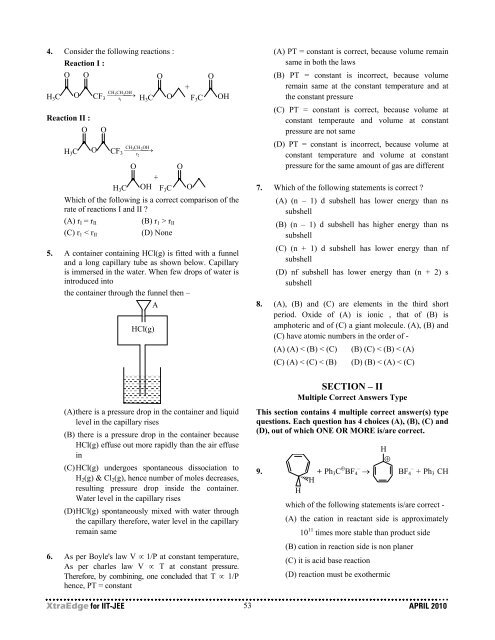Solution - Career Point
Solution - Career Point
Solution - Career Point
You also want an ePaper? Increase the reach of your titles
YUMPU automatically turns print PDFs into web optimized ePapers that Google loves.
4. Consider the following reactions :Reaction I :O OOH 3 COReaction II :OH 3 CCH CH2OH3CF 3⎯r1OO⎯⎯⎯3CF 3⎯r2→ H 3 CCH CH2OH⎯⎯⎯→O+F 3 COOHOOH 3 C OH+F 3 C OWhich of the following is a correct comparison of therate of reactions I and II ?(A) r I = r II(B) r 1 > r II(C) r 1 < r II(D) None5. A container containing HCl(g) is fitted with a funneland a long capillary tube as shown below. Capillaryis immersed in the water. When few drops of water isintroduced intothe container through the funnel then –AHCl(g)(A) there is a pressure drop in the container and liquidlevel in the capillary rises(B) there is a pressure drop in the container becauseHCl(g) effuse out more rapidly than the air effusein(C) HCl(g) undergoes spontaneous dissociation toH 2 (g) & Cl 2 (g), hence number of moles decreases,resulting pressure drop inside the container.Water level in the capillary rises(D) HCl(g) spontaneously mixed with water throughthe capillary therefore, water level in the capillaryremain same6. As per Boyle's law V ∝ 1/P at constant temperature,As per charles law V ∝ T at constant pressure.Therefore, by combining, one concluded that T ∝ 1/Phence, PT = constant(A) PT = constant is correct, because volume remainsame in both the laws(B) PT = constant is incorrect, because volumeremain same at the constant temperature and atthe constant pressure(C) PT = constant is correct, because volume atconstant temperaute and volume at constantpressure are not same(D) PT = constant is incorrect, because volume atconstant temperature and volume at constantpressure for the same amount of gas are different7. Which of the following statements is correct ?(A) (n – 1) d subshell has lower energy than nssubshell(B) (n – 1) d subshell has higher energy than nssubshell(C) (n + 1) d subshell has lower energy than nfsubshell(D) nf subshell has lower energy than (n + 2) ssubshell8. (A), (B) and (C) are elements in the third shortperiod. Oxide of (A) is ionic , that of (B) isamphoteric and of (C) a giant molecule. (A), (B) and(C) have atomic numbers in the order of -(A) (A) < (B) < (C) (B) (C) < (B) < (A)(C) (A) < (C) < (B) (D) (B) < (A) < (C)SECTION – IIMultiple Correct Answers TypeThis section contains 4 multiple correct answer(s) typequestions. Each question has 4 choices (A), (B), (C) and(D), out of which ONE OR MORE is/are correct.9.H+ Ph 3 C ⊕ BF – 4 →HH⊕BF 4 – + Ph 3 CHwhich of the following statements is/are correct -(A) the cation in reactant side is approximately10 11 times more stable than product side(B) cation in reaction side is non planer(C) it is acid base reaction(D) reaction must be exothermicXtraEdge for IIT-JEE 53APRIL 2010
















